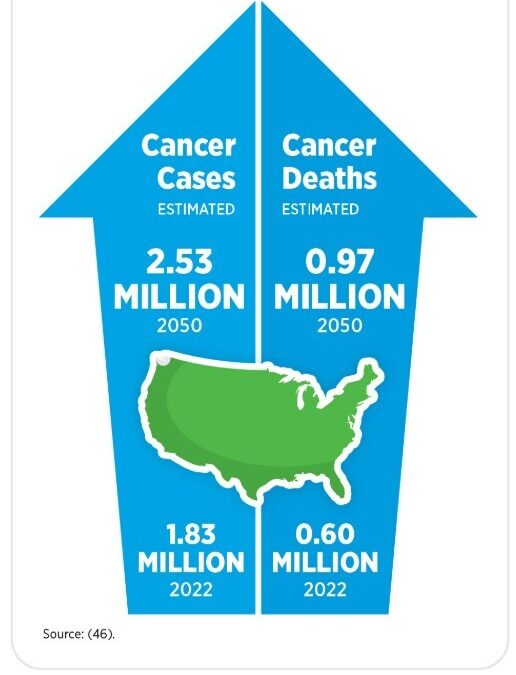Over the past five years, the landscape of cancer research and care has undergone significant transformation, marked by both challenges and breakthroughs. Let’s explore the key developments, current trends, and future prospects in this critical field.
Incidence, Prevalence, and Survival Rates
The global burden of cancer continues to be a pressing concern. In 2022, there were approximately 19.9 million new cancer cases worldwide [5]. The most common types of cancer included:
1. Trachea, bronchus, and lung cancer (2.48 million cases)
2. Breast cancer (2.29 million cases)
3. Colorectal cancer (1.93 million cases)
4. Prostate cancer (1.47 million cases)
5. Stomach cancer (968,784 cases)
Despite the high incidence rates, there’s encouraging news on the survival front. In the United States, the cancer death rate has declined by 33% since 1991 [6]. This translates to approximately 3.8 million cancer deaths averted over the past 30 years. The overall five-year survival rate for all cancers combined has improved from 49% in the mid-1970s to 68% in recent years [6].
Certain cancers have shown particularly impressive survival rates:
– Thyroid cancer: 98%
– Prostate cancer: 97%
– Testicular cancer: 95%
– Melanoma: 94%
However, it’s important to note that progress hasn’t been uniform across all cancer types. Some cancers, such as pancreatic and brain cancers, continue to have lower survival rates and require intensified research efforts.
Recent Breakthroughs and Developments
The past five years has witnessed significant progress in cancer research and treatment:
1. Immunotherapy: Checkpoint inhibitors have revolutionized treatment for many cancer types. A notable success story is CAR-T cell therapy, which has shown remarkable results in leukemia patients, with some remaining in remission for over a decade [2].
2. Precision Medicine: The integration of genomic data in cancer treatment has led to more personalized and effective therapies. The 100,000 Genomes Project in the UK has successfully used genomic data to pinpoint effective treatments more accurately [2].
3. Liquid Biopsies: Advances in detecting circulating tumor DNA (ctDNA) in blood samples have improved early cancer detection and monitoring of treatment response [7].
4. AI-Driven Diagnostics: Artificial Intelligence tools have shown promise in improving cancer detection and prediction of treatment outcomes. For instance, Mayo Clinic developed an AI tool that can process complex healthcare data to enhance cancer diagnostics and treatment personalization [7].
5. Novel Drug Discovery: AI-powered approaches have accelerated the drug discovery process. For example, the cancer drug BBO-8520, targeting KRAS mutations, reached clinical trials in just three years of development [7].
The Future of Cancer Research: AI and Machine Learning
The integration of Artificial Intelligence and Machine Learning in cancer research is poised to revolutionize the field in the coming years. Here are some key areas where AI is expected to make significant impacts:
1. Early Detection and Diagnosis: AI models like CHIEF (Computational Histopathology-Informed Evaluation Framework) have shown remarkable accuracy in cancer detection across multiple cancer types. CHIEF achieved nearly 94% accuracy in cancer detection and outperformed current AI approaches across 15 datasets containing 11 cancer types [9].
2. Personalized Treatment Plans: AI tools are becoming increasingly adept at analyzing patient data, including genetics, clinical history, and tumor profiles, to create highly personalized treatment plans [7].
3. Drug Discovery and Development: AI is accelerating the drug discovery process by analyzing vast datasets to identify potential drug candidates more quickly and accurately than traditional methods [11].
4. Predictive Analytics: Advanced AI models are improving the prediction of patient outcomes and treatment responses, potentially revolutionizing clinical decision-making[9].
5. Imaging and Pathology: AI is enhancing the accuracy and efficiency of cancer imaging and pathology, leading to faster and more precise diagnoses[9].
Implications for Life Science Marketing
The rapid advances in cancer research and AI integration have significant implications for professionals in life science marketing:
1. Digital Transformation: Over half of finance leaders in pharma are now focusing on digital transformation. Marketers need to adapt to this shift and leverage digital tools to reach healthcare professionals effectively [10].
2. AI-Driven Marketing Strategies: As AI becomes more prevalent in cancer care, marketers should incorporate AI-driven insights into their strategies to better target and engage healthcare professionals [10].
3. Personalized Communication: With the rise of precision medicine, marketing efforts should focus on delivering personalized, relevant information to healthcare providers and patients[10].
4. Emphasis on Data Privacy: As AI systems process more sensitive health data, marketers must prioritize data privacy and security in their campaigns [10].
5. Omnichannel Approach: The future of life science marketing lies in adopting an omnichannel strategy to engage healthcare professionals across various platforms [10].
6. Education and Awareness: Marketers will play a crucial role in educating healthcare professionals about new AI-driven diagnostic tools and treatments [12].
7. Collaboration Opportunities: The ongoing wave of rebranding and restructuring in big pharma presents opportunities for life science marketers to collaborate on shared narratives focused on innovation [12].
As we look to the future, the synergy between cutting-edge cancer research and advanced marketing strategies will be crucial in translating scientific breakthroughs into improved patient outcomes. The next five years promise to be an exciting and transformative period in the fight against cancer, with AI and machine learning at the forefront of this revolution.
Citations:
[1] Our top 5 cancer research breakthroughs of 2022
[2] 12 new breakthroughs in the fight against cancer
[3] Envisioning the Future of Cancer Science and Medicine
[4] Cancer statistics, 2024 – PubMed
[6] Cancer Survival Rates Are Improving, Researchers Say
[7] The AI boom in oncology: Game-changer or just hype?
[8] AI tool predicts response to cancer therapy | National Institutes of Health (NIH)
[9] New AI tool can diagnose cancer, guide treatment, predict patient survival— Harvard Gazette
[10] Life Sciences Marketing in 2024: What’s Next and Why it Matters – Spiceworks
[11] Artificial Intelligence (AI) in Cancer Market to Grow at a CAGR of 23.1%

